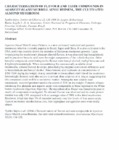Use este identificador para citar ou linkar para este item:
http://www.alice.cnptia.embrapa.br/alice/handle/doc/312070Registro completo de metadados
| Campo DC | Valor | Idioma |
|---|---|---|
| dc.contributor.author | STIJVE, T. | pt_BR |
| dc.contributor.author | AMAZONAS, M. A. L. | pt_BR |
| dc.contributor.author | GILLER, V. | pt_BR |
| dc.date.accessioned | 2014-08-16T06:33:40Z | - |
| dc.date.available | 2014-08-16T06:33:40Z | - |
| dc.date.created | 2006-07-27 | pt_BR |
| dc.date.issued | 2004 | pt_BR |
| dc.identifier.citation | Australasian Mycologist, v. 22, n. 2, 2004. | pt_BR |
| dc.identifier.uri | http://www.alice.cnptia.embrapa.br/alice/handle/doc/312070 | pt_BR |
| dc.description | Agaricus blazei Murrill sensu Heinem. is a new cultivated medicinal and gourmet mushroom which is currently popular in Brazil, Japan and China. It is also cultivated in the USA, and it has recently drawn the attention of European mushroom growers. Upon investigating the mushroom's pleasant almond flavour, it was observed that benzaldehyde and its precursor benzoic acid were the major components of the volatile fraction. Other benzylic compounds contributing to the flavour were benzyl alcohol, methyl benzoate and 4-hydroxybenzaldehyde. When reconstituting the commercially available dried mushrooms, almond flavour develops, presumably by enzymic conversion of benzoic acid to benzaldehyde and benzyl alcohol. Since benzoic acid is present at concentrations of 1280-3100 mg/kg dry weight, it may contribute to the excellent shelf life of the mushroom. Interestingly, benzoic acid also occurs in several close relatives of A. blazei, suggesting that this compound could well be a taxonomic marker. Among the non-volatile taste compounds, mannitol predominated to the extent of 22% on dry weight. Contents of taste-enhancing free glutamic and aspartic acids were comparable to those reported in the White button mushroom (Agaricus bisporus). The mycelium of A. blazei was found to be poor in nearly all compounds investigated. No almond flavour was observed and its crude protein content was only 13% compared with an average value of 30% in the dried mushrooms. Moreover, it had less than 1% of mannitol and only very low levels of free amino acids. Typical secondary metabolites as urea, free tryptophan and agaritine were even totally absent. | pt_BR |
| dc.language.iso | eng | eng |
| dc.rights | openAccess | eng |
| dc.subject | Agaricus blaze | pt_BR |
| dc.subject | Composição | pt_BR |
| dc.title | Characterisation of flavour and taste compounds in Agaricus blazei murrill sensu Heinem., the cultivated almond mushroom. | pt_BR |
| dc.type | Artigo de periódico | pt_BR |
| dc.date.updated | 2014-08-16T06:33:40Z | pt_BR |
| dc.subject.thesagro | Cogumelo | pt_BR |
| dc.description.notes | Resumo. | pt_BR |
| riaa.ainfo.id | 312070 | pt_BR |
| riaa.ainfo.lastupdate | 2014-08-15 | pt_BR |
| Aparece nas coleções: | Artigo em periódico indexado (CNPF)  | |
Arquivos associados a este item:
| Arquivo | Descrição | Tamanho | Formato | |
|---|---|---|---|---|
| Characterisation0001.pdf | 922 kB | Adobe PDF |  Visualizar/Abrir |









